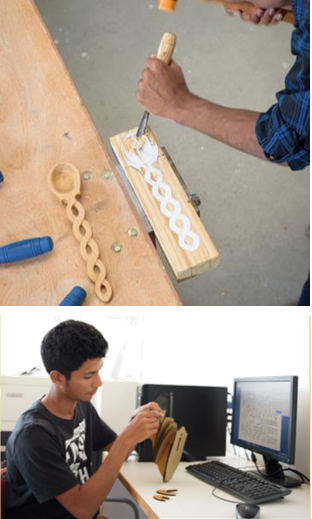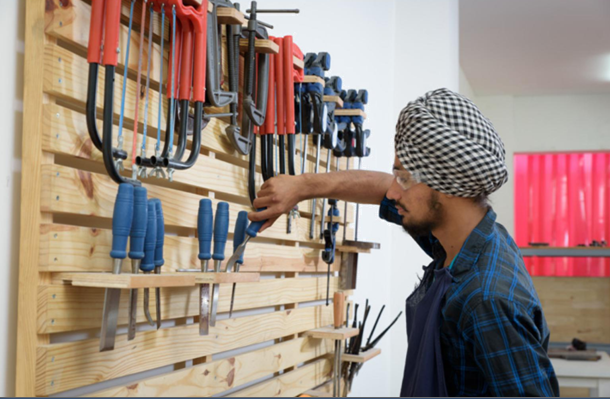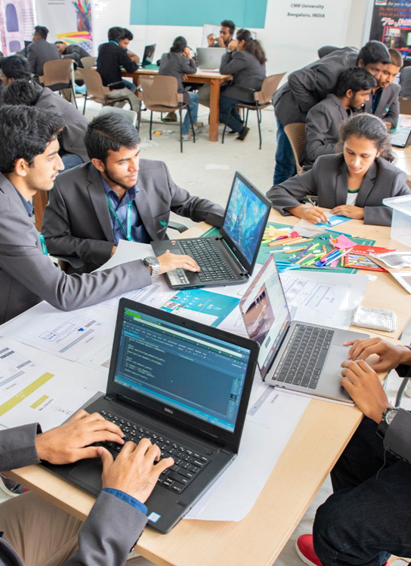Power Tools
Maker Space has a collection of hand and power tools to aid in building your projects. Some of them are:
- Saws (Hack, pipe, hand)
- Chisels
- Screw-drivers
- Wrenches
- Files
- Ratchets and sockets
- Clamps and vices and many more
Announcements
A Maker’s tool chest is not complete without an assorted collection of power tools that speed up the task of getting the work done. The collection of power tools at the Maker Space include
Maker Space has a collection of hand and power tools to aid in building your projects. Some of them are:


Stages of Design Thinking in Maker Space
Identify the Challenge
Explore and Research
Become Social
Develop Cognizance
Ignite the Creativity
Prototypes with multiple ideas
Share your ideas
Design thinking is a creative approach to solving complex problems of different natures; from engineering and manufacturing a new product, improving in-patient experience in hospitals, all the way to cities adapting to climate change.
Being a human-centred process, it prioritizes user needs by using empathy-building methods that deepen the understanding of the context. It integrates human desirability, technical feasibility and business viability to provide holistic, and unprecedented solutions.
Design Thinking is process-oriented and brings together methods and techniques that enable us to think of and explore countless solutions to a specific challenge. Being an iterative process that encourages prototyping your ideas from an early stage it puts concepts to test. It encourages people to learn from failures, see connections between seemingly unrelated parts, identify valuable insights and build resilience to keep trying till a successful outcome is achieved.
At CMR our vision is to “Nurture creative thinkers who will drive positive global change.” Skills in Design Thinking builds confident, innovative leaders, and makers that can think critically, access and make sense of information, communicate effectively and work together in teams while empathizing; and following their informed intuition.
CMR seeks to empower students to become concerned citizens of the world sensitized to their social responsibilities. By learning problem-solving skills and cross-disciplinary thinking they are equipped to be active and driven members of their communities.

IDENTIFYING THE CHALLENGE
Understanding the full context of a situation and recognizing its problem areas brings us closer to solving the challenge at hand. By mapping all that we know, we can understand how the users are affected by the problem, define the critical needs and gain clarity on where our attention is most needed.
EMPATHIZING WITH OTHERS
To generate useful and effective solutions it is important for us to set aside our preconceived notions and prejudices about users and stakeholders. By genuinely connecting with the users we can understand and respect their values, mindsets and identities. This allows us to create holistic solutions that are meaningful to the stakeholders.
RESEARCHING TO EXPLORE
Investigating the challenge at hand is essential to gather facts and confront assumptions. Examining and testing our previous knowledge allows a more thorough understanding of the problem and its context, helping us become experts on the matter. Data gathered in research can be used to validate or question ideas.
ORGANIZING TO UNDERSTAND
When faced with large quantities of information it is essential to identify the material that is useful. With the help of organizational tools, we can filter and group data and identify commonalities, differences and other interesting observations. These techniques increase knowledge about a problem and inform future decision-making.
ENVISIONING MULTIPLE IDEAS
To arrive at innovative and unique concepts it is important to go through an exhaustive process of ideation. The focus of the idea generation processes is to think divergently and produce a vast quantity of diverse ideas. By exploring multiple variations and approaches, an appropriate outcome can be achieved.
DEVELOPING A CONCEPT
To design a powerful concept it is important to refine and strengthen your ideas by combining, evaluating and reworking them. The decision-making process of convergent thinking helps establish what is most critical moving forward with a design and provides the framework to generate a well-rounded solution.
PROTOTYPING TO EXPERIMENT
Prototyping seeks to test and provide validation for concepts by materializing them in different mediums. Through making from an early stage, the idea is informed by iterative experimentation. Prototyping helps evaluate the functionality and validates future creative choices. This process refines and strengthens the solution reducing risks and potential mistakes.
TESTING FOR FEEDBACK
Collecting feedback is crucial when assessing if an idea is working the way it is intended to. From an initial vision to the finished design, asking users, stakeholders and experts for their opinions, insights and perspectives are necessary to improve user interactions and validate the concept.
PRESENTING AND SHARING
Explaining and validating ideas in a convincing and compelling way is fundamental in adding value and broadening the reach of a solution. Presentation techniques simplify complex concepts so that they are easily understood by a new audience in a holistic way. Documentation is a crucial part of the sharing experience. It helps retrace your process and makes for a strong argument by objectively validating the decisions that were made.